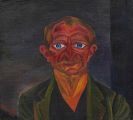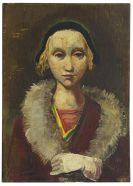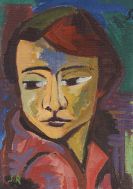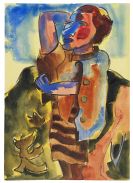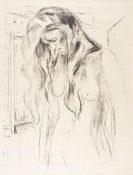
Manfred Henninger
Backnang
1894 -
Stuttgart
1986
Manfred Henninger, born in Backnang, Württemberg, on 2 December 1894, at first trained as a a pastry cook at his father's business in Tübingen. Henninger volunteered for military service in 1914, was gravely wounded and from 1916 took lessons from Heinrich Seufferheld, a university instructor of draughtsmanship. In 1919 Henninger began to study at the Stuttgart Art Academy, where Pötzelberger was one of his teachers. He did numerous landscapes while staying in the Allgäu during the summer of 1921. That same year the Mannheim Kunsthalle acquired a self-portrait of Henninger's. Henninger continued his studies from winter term 1922 at the Dresden Academy under Albiker and Kokoschka. Later Henninger went to Berlin, where he was admitted to important private collections at the recommendation of the art historian Julius Meier-Graefe. Henninger first saw Picassos at the Mendelson house, Impressionists and a collection of Cézannes at the Cassirers'. In 1926 Manfred Henninger had his first one-man show at the Kunsthaus Schaller in Stuttgart. In 1929 Henninger joined forces with Manfred Pahl, Wilhelm Geyer, Alfred Lehmann and Gustav Schopf to found the 'Stuttgart New Secession'. After successful exhibitions, Manfred Henninger emigrated to Switzerland for political reasons and later went to Ibiza. The Balearic Islands inspired one of Henninger's most prolific and creative periods, during which he did some three hundred oil paintings. Henninger left Ibiza and moved to Tonco in the Ticino to escape the Spanish Civil War. In 1941 Henninger first began to work with ceramics and wrote essays on the French Impressionists for the magazine 'Blätter für die Kunst'. Despite the generous help extended by some of his fellow artists, Henninger suffered from poverty and isolation during the war years in exile because he was not able to join in on the Swiss art scene. Appointed to the State Academy of Fine Arts in Stuttgart in 1949, he returned to Germany. At that time Henninger was concentrating on large-scale murals and figurative pictures. Following his retirement in 1961, Henninger came to focus more on drawing and prints: he did illustrations to Ovid's 'Metamorphoses' and his first ballet drawings and drawings and pastels to illustrate Virgil's 'Georgics'. In 1967/68 Manfred Henninger was a guest at the Villa Massimo in Rome. In 1975 a large-scale retrospective of Henninger's work was mounted at the Württembergischer Kunstverein in Stuttgart. Henninger continued to travel to southern Europe to paint and find inspiration for his work until a very old age. Manfred Henninger died in Stuttgart on 5 October 1986.
Would you like to sell a work by Manfred Henninger?
Infos for seller

